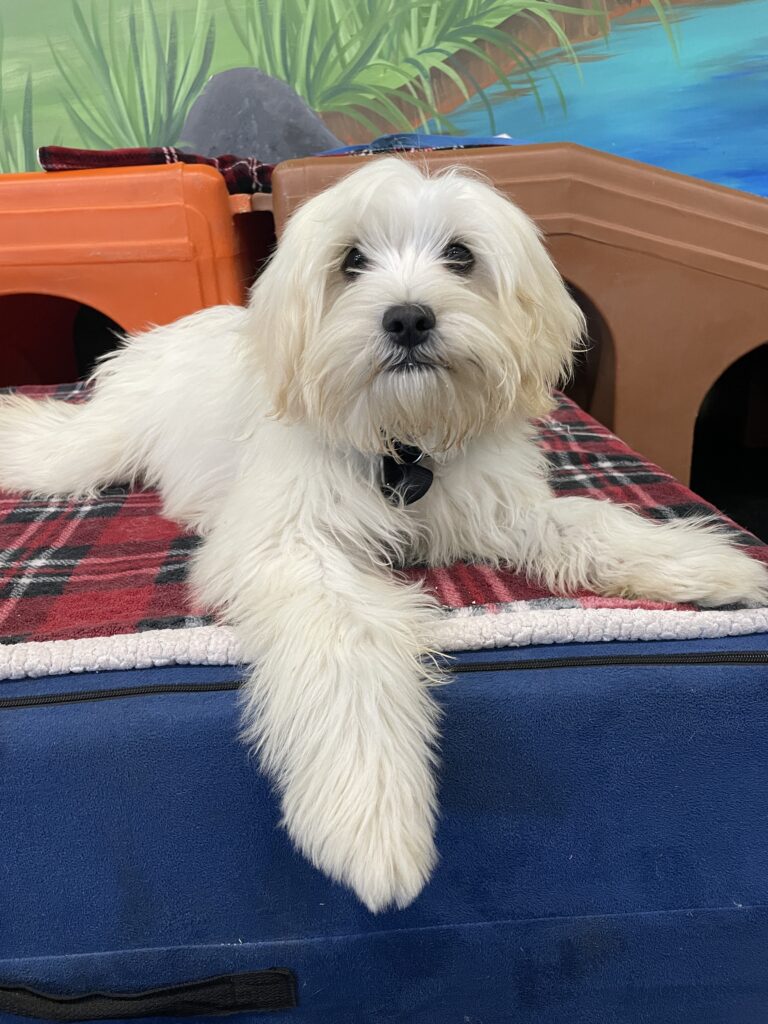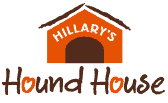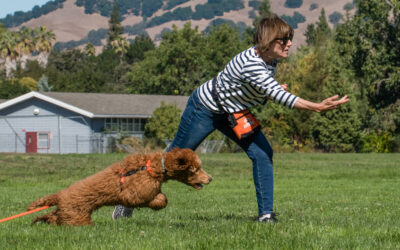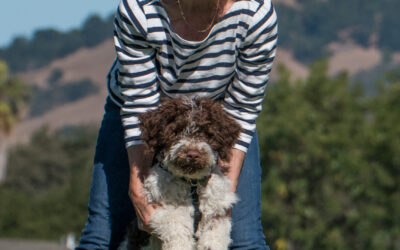In my quest to create the optimal puppy environment, I have discovered that cultivating a calm, predictable environment is key to everything from potty training to a puppy’s ability to focus, to learn and retain new skills – even to rest properly.
“And yet, visit the Nursery on any day and you’ll find 10 to 12 puppies relaxing in their pens quietly. The absence of barking is the first thing people notice.”
On a given day in the Jumpstart Nursery we’ll have between 10 and 12 puppies so if we didn’t have a calm, predictable environment life would be chaos! And yet, visit the Nursery on any day and you’ll find 10 to 12 puppies relaxing in their pens quietly. The absence of barking is the first thing people notice.
The whole idea of cultivating an optimal learning environment for puppies was brought home to me yet again this month when a 4-month old Havanese puppy called Baxter arrived with potty training issues. At home there are three children, ages 3, 6, and 9 – all smitten with their new puppy. They couldn’t wait to spend time with him and as we discovered, could not leave him alone.

When Baxter began the Jumpstart Program he was having multiple potty accidents at home. He was a sensitive puppy, highly distractible and easily excited. Yet despite taking him out hourly, going on walks, and keeping him busy he continued to potty indoors.
“Things came to a head one night when the eldest of three children pulled Baxter from his crate to say goodnight. In the ensuing rush and tumble of the moment, Baxter nipped his ear.”
Bedtime at Baxter’s included excited running around with lots of good-night kisses and hugs from each child. When the children finally got into bed Baxter would spend the next hour barking and whining, unable to settle. Things came to a head one night when the eldest of three children pulled Baxter from his crate to say goodnight. In the ensuing rush and tumble of the moment, Baxter nipped his ear. A scratch really but a shock, nonetheless and a predictable reaction to the constant touching, handling, excited movement and daylong interruptions. It was a lot for any puppy to handle.
“Suddenly it was clear why Baxter had so little control over his bodily functions, why he couldn’t fall asleep at night, and had become increasingly dysregulated.”
The children could not leave him alone and he had no quiet time away from them.
A clue to this dilemma arose when Baxter was left downstairs one night in his pen while the kids brushed their teeth and got ready for bed. When everyone went downstairs to say goodnight, they found him fast asleep in his pen. Happily, they didn’t wake him and for the first time he slept through the night.
We brainstormed about how and when to give Baxter quiet time and came up with a plan that included taking turns and more supervision of each of the children’s time with him. Quiet time in the evening allowed Baxter to settle and by the second week Baxter had no accidents in the Nursery and far fewer at home. He continued to improve with more quiet time at home, time to notice how his body felt, to become aware of when he needed rest, and when he needed to go outside.
Here are some rules I shared with Baxter’s family that I’ve found helpful – especially with small children to help ensure your puppy doesn’t become overwhelmed or over-stimulated;
1. Only adults pick up the puppy. This is especially important for children under 6 or 7 because they frequently lose their balance with a squirming puppy and are not able to support each of a puppy’s limbs. Children also tend to pick up puppies swiftly and without warning. This is disconcerting and sometimes scary for puppies. The downside is that puppies soon begin to growl and become hesitant to be around children.
2. One, “trainer,” at a time. I’m all for taking turns but this is challenging for siblings who tend to become competitive or even bossy with each other. The downside of this is two sets of arms grasping or restraining a puppy. This rule assures everyone their turn without interruption. When children understand this, they are frequently willing to wait for theirs. It also helps with play dates because even visiting children have their time with a new puppy (provided the puppy is up for it and unafraid).
3. Time with a puppy takes place in the same room as an adult. No one takes the puppy to another room or out of sight. There is always an adult to supervise the encounter.
4. Assigned times for potty training, walks, and other activities. Since we are taking a puppy out every 45 to 50 minutes to go potty you can assign times to each of your children. For example, when the timer goes off for 3pm it signals that child’s turn to take him out. When 4pm arrives, it’s another child’s turn. This helps involve the whole family in potty training rather than just the adults.
5. Letting Your Puppy Choose, is a game that helps children begin to understand and respect a puppy’s need for space. This is a nice game you can play is to have the children sit on the floor and wait for their puppy to approach them. If he walks away, goes to an adult, lays down or tries to leave the room he’s choosing something other than the children. It’s important to honor this – and not have hurt feelings – this is a tough one for children and though it may temporarily lead to hurt feelings it’s important to validate a puppy (or child’s) choice of quiet time and to encourage both to take it. It’s a win-win for both when it comes to self-regulation and impulse control.
I’m pleased to say that within two weeks of changing Baxter’s home environment, the accidents stopped. He became calmer, began to learn new skills, and began go potty on cue outside.
“Young puppies are similar to toddlers. I can no more take my eyes off a toddler than I can a puppy. Together, they make a volatile combination at home.”
Baxter is one of many puppies we have had over the years that improved dramatically when his home environment became calmer and more predictable. We have so many children in the program at any given time that it’s now my first line of questioning when a puppy becomes dysregulated and has potty accidents at home.
I find that young puppies are similar to toddlers. I can no more take my eyes off a toddler than I can a puppy. Together, they make a volatile combination. Yet in a predictable, controlled environment puppies learn quickly and become potty trained easily.
“Try new habits. For example, at naptime in the Nursery we tune to the Native American flute music. It’s the same channel every day and it never fails. When lights go out every puppy from most hyper to calmest is fast asleep.”
You can condition calm at home by creating new habits. For example, at naptime in the Nursery we tune to the Native American flute music. It’s the same channel every day and it never fails. When lights go out every puppy from most hyper to calmest is fast asleep. Another habit is making sure your puppy has his meals in a quiet space, away from children and their activities.
This is all well and good at home. What about outdoors, where all bets are off and things aren’t calm?
Up Next: Optimal Learning Series – Part 2 Preparing Your Puppy for the Great Outdoors



